Your guide to the biggest players, teams, and stories of the 2024 D-III college season!
January 26, 2024 by Anna Browne, Zack Davis, Raquel Alegria and Theresa Diffendal in Preview with 0 comments

Ultiworld’s coverage of the 2024 college ultimate season are presented by Spin Ultimate; all opinions are those of the author(s). Find out how Spin can get you, and your team, looking your best this season.
A few weeks after the New Year’s ball drops wrap up, the murmur of the coming college season begins in earnest. By the time it’s nearly February, the whirring of the hype machine is hitting a fever pitch. As the first major tournament weekend approaches, we want to make sure you’re fully prepared for another uproarious college season. Like those that came before it, get ready for the ups, the downs, the thrillers, the stars, the new kids, and all of the wonderful things that make college ultimate so beloved with our annual College Primer.
Major Storylines
The Argument for Middlebury’s Fourpeat
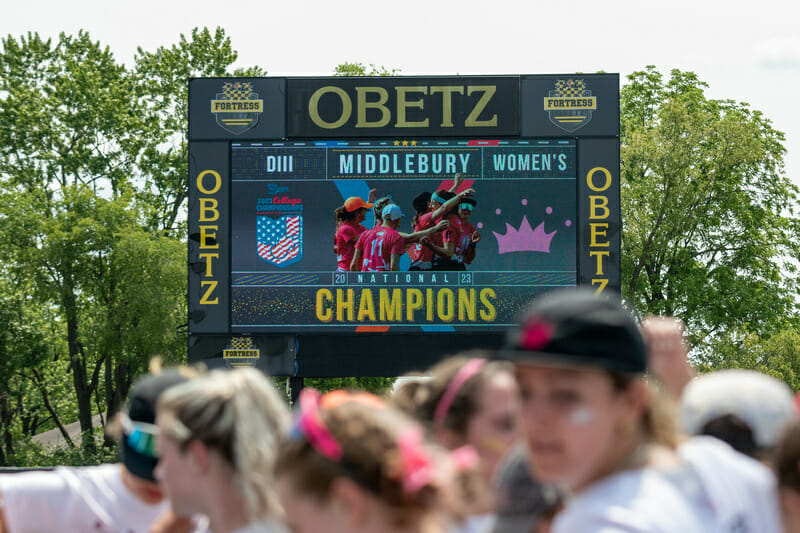
It’s difficult for any college team to build what would be labeled as a dynasty, especially in ultimate where scholarships and official school support are hard to come by. Middlebury, however, has found a way to defy the odds. After winning their third national title in a row and graduating nearly two lines worth of players the Pranksters find themselves back in the driver’s seat and looking to make history. To get them back to the top of the mountain are defending POTY Keziah Wilde, as well 2023 ROTY Lucy VanNewkirk. Alongside these big names are other certifiable all-star returners such as Sarah Rifkin and Liz Crawford.
In a division so heavily influenced by top talent, Middlebury has always been careful to take care of the details. There’s never anyone who feels exploitable, doesn’t know their role, or is nervous with the disc in their hand. For a team whose coach is a lawn ornament in a tutu, the Pranksters are incredibly well coached. Part of this is the institutional knowledge passed down from player to player. It’s common for their players to be discussing the finer points of a cut or giving pointers on how best to mark a certain player. Another part of their poise? They play in the best region in the nation, and steel sharpens steel. It’s easier to stay at peak form when you’re constantly playing top-of-the-table teams and meeting up with Nationals-level opponents every tournament. The biggest boon to the team, however, is their vibe. Middlebury has fun, they’re open, and they’re silly.
This isn’t to say other teams aren’t, but there’s something magnetic about the Pranksters, an aura that I’m sure serves them well during recruiting season. Don’t get it twisted though: just because their recipe for success can be captured in the preseason primer doesn’t mean what the Pranksters are doing is by any means easy. Sure they seem to do all this effortlessly, but it’s clear every player is bought in heart and soul, and their investment keeps paying off.
To be clear however, this seems to be the most vulnerable the Pranksters have been since 2019, and the elephant in the room is Claire Babbott-Bryan’s graduation. In conjunction with the massive gap left by CBB and the other 10 graduating seniors, teams like Portland, St. Olaf, and regional rivals Williams all seem to be reaching the next level this year. Plus perennial powerhouse Carleton Eclipse is always lurking in the Top 5.
Even with all of those things in consideration though, the Pranksters have only downgraded from unbeatable to merely clear favorites.
Is This Carleton/Wellesley/Portland’s Year?
Middlebury has been at the top of the D-III Women’s Division for the last 3 seasons. That’s just a fact. While they’ve had numerous challengers since 2024, their closest games at Nationals have not been all that close. With 15-10 wins in the national final over Portland in 2021 and Wellesley in 2022, Middlebury proved they know how to show up in big games.
Against Carleton College Eclipse in 2023, the teams were fairly even up until 5-5, when Middlebury went on a 6-0 run. At 14-8, Carleton put together a four point comeback, but it wasn’t enough to overcome the deficit. Outside of the national final, Middlebury’s closest games – all wins – at Nationals were 15-10 against Portland in the 2023 semifinal, a 12-8 win over Haverford in the quarterfinal of 2022, a 15-10 win over SUNY-Geneseo in pool play in 2022, and a 15-11 win over Truman State in the semifinal of 2021. With historical results like these, it’s hard to argue against the Pranksters.
However, Middlebury has some big losses going into 2024. While they’ve been able to retool in the past, Middlebury will have to do it without their clear superstar for the first time since before the pandemic. Alongside a borderline last-second collapse against Carleton in the 2023 final, this looks like the year Middlebury will finally be bested.
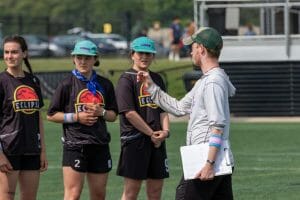
Looking at the most logical choices to best Middlebury – our 2023 semifinalists Carleton, Wellesley, and Portland – there seem two clear front runners who could make it happen in Carleton and Portland. Carleton has the recent pedigree with that close loss last season. However, they suffer similar losses to Middlebury, losing six graduating seniors who were instrumental in their late game run. That said, Eclipse have proven they can retool with a phenomenal coaching staff and players who truly want to lead and grow as a team. They also return key players like Rowan Dong and Frankie Saraniti, in addition to younger players set to step up in Zoe Marquis, Maddy Brown, Tess Barton, and an incoming 3-star YCC player in Molly Horstman. Carleton has the system, the buy-in, and the dedication to take the throne from Middlebury; can they put all the pieces together?
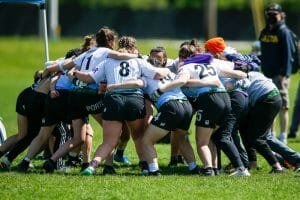
The next team with a shot to best Middlebury this season is Portland. While Portland is in a similar boat to Middlebury and Carleton, losing 10 players to graduation, they could stand out by returning two of the biggest immediate contributors in the division in Julianna Galian and Hayden Ashley. Last season, Ashley was able to find incredible success at Nationals in just her first season. With another year of chemistry building for Ashley and Galian, this could be an unstoppable connection. Portland also brings back a stellar coaching staff, so expect them to retool faster than most.
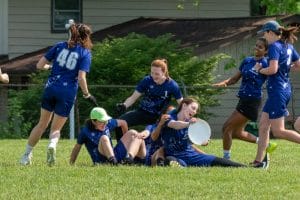
Our final team to review may be the team with the biggest hurdles to overcome: the Wellesley Whiptails. Wellesley, like every other 2023 semifinalist, loses some key players to graduation. Wellesley is losing eight of their 18-person Nationals roster, including Donovan winner Tess “Roo” Dolan and Leah Black. Additionally, Ella McHugh, a breakout player at Nationals, is studying abroad this spring semester. In an argument for Wellesley’s success, they are returning Bella Steedly and Annika Wolberg and a great coaching staff. Alongside that, Wellesley frequently plays Middlebury and other very strong teams in the New England region throughout the season when compared to the other two semifinalists. Will it be enough to defy our staff’s early season pessimism and make another title run?
Will a Fourth Region Rise to Claim an Elusive Strength Bid, or Will the Three Powerhouse Regions Gobble Up the Bids Yet Again?
Since the bid picture returned to normal following the pandemic, a few powerhouse regions have clearly emerged across the northern portion of the women’s division: New England, North Central, and Northwest. In the past two seasons, these three have claimed all six strength bids rather convincingly. Not only that, the last two teams out of bid earning position were both from a power region – Lewis & Clark from the NW and Bates from NE.
The cream of the crop of these power regions is, without a doubt, New England. With Middlebury leading the way with three consecutive championships, NE has benefitted from the adage that iron sharpens iron, with five teams in the top 12 of USAU’s 2023 end of season rankings. This clearly wasn’t an algorithm fluke, as all four teams who made Nationals finished in the top half of the field.
That said, with Wellesley set to take a step back due to graduation losses and Middlebury losing 2021 and 2022 POTY Claire Babbott-Bryan, amongst others, will New England maintain its control over three of the six strength bids without the clear number 1 and 2 teams in the rankings? With a few other regions rising, including the other two power regions, New England may be truly tested.
Arguing for the NE’s continued prominence at the top of the division, Williams and Mount Holyoke both performed well at Nationals even with younger teams. Both lost close to title-contender teams, with Williams falling to Portland 15-9 and Mount Holyoke to Carleton College Eclipse 15-11. These teams also have minimal turnover. Mount Holyoke’s biggest losses are big, with Gabbi Perry and Gigi Downey graduating. For Williams, they have less big names, but still lose five solid players to graduation. With Skyler Yarter and Emily Stanger returning for Williams, they could step up into that NE2 slot behind Middlebury and help the region retain four bids for 2024.
While New England definitely could maintain their seat at the top, several regional challengers are going to be pushing hard for those extra strength bids. The North Central and Northwest are looking to take the torch with teams like Portland, Whitman, and Lewis & Clark for the NW and Carleton College Eclipse, St. Olaf, and Michigan Tech for the NC poised to step up this season. Remember, in 2023 the NC had three bids while the NW only had two.
While earning an additional strength bid for a power region is hard, it’s arguably harder to claim a strength bid as a challenger region. With 10 of the 16 bids being autobids and several of those claimed by teams outside the top 16, a region essentially needs to get two teams within the top 10 to even have a chance at a strength bid.
Though a tall order, a few challenger regions could overcome the hurdle and make a run at an additional bid in 2024 – the South Central and Ohio Valley. In the South Central, three teams have risen to the top of the region: Colorado College, Trinity, and Rice. If these teams perform well at Centex in March, the SC could very well claim another bid.
The Ohio Valley could claim a bid with a “rising tide lifts all boats” situation, and Haverford/Bryn Mawr leading the way. Lehigh just missed Nationals with a 7-5 loss to Haverford/Bryn Mawr in the regional final, and could be set to rise as well. These two teams attend plenty East Coast tournaments in the spring. If they both perform well at tournaments like Bring the Huckus and Garden State, the Ohio Valley could see itself claiming a strength bid for 2024.
What’s Stronger for 2024: Consistently High-Performing Teams who Lost Key Players, or Teams who Missed Semis Recently but with Minimal Turnover?
Turnover is a fact in college ultimate. With D-III consisting mainly of liberal arts schools due to the 7500 student cap, it’s rare to have a fifth- or sixth-year within the division. While YCC and high school players are becoming more and more common throughout the country, most D-III Women’s teams consist predominantly of players with minimal to no ultimate experience when they join their college’s team. As a result, institutional knowledge and on-field chemistry built up by present and former captains and coaches can make the difference in the women’s division.
Since the pandemic, we’ve seen two types of schools. The first are those who came out of the gate quickly at fall 2021 Nationals – Middlebury, Carleton College Eclipse, Portland, and Wellesley – and they’ve continued to dominate the division. For the last three seasons, these teams had a high retention of game changers and constituted 10 of the last 12 semifinalists. On the other side of things, there are a few rising teams, including some who haven’t reached their pre-pandemic levels in St. Olaf, Williams, and Bates, as well as newer teams on the block in Whitman and Colorado College who seem to be hitting their stride this season. With the perennial semifinalists starting to lose some key players to graduation, will 2024 finally be the year that we see a new guard replacing the post-pandemic juggernauts, or will institutional knowledge and experience prevail?
Players to Watch
Some of the players we think will define the 2024 college season.
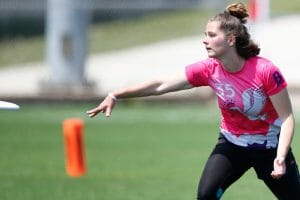
Keziah Wilde (Middlebury)
The reigning POTY and known slinger of plastic Keziah Wilde is the best player on the best team and will define the 2024 season. She’s far from a game manager and has the ability to both dice up a handler set and launch the disc deep down field to any of the incredibly talented receivers on the Middlebury team. Often she does both on the same point. She’s a player to watch because watching her play is often a delight, as well as a learning experience for any aspiring handler.
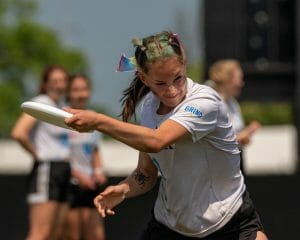
Leina Goto (St. Olaf)
With powerful and accurate throws, Leina Goto was the center cog for the Vortex offense in 2023. After finishing her 2023 season as a second team All-American, she’ll look to at least repeat her performance this year. The now junior looked poised and, if anything, a little too willing to take shots downfield at Nationals. Goto wasn’t only making it happen from the back field on the O-line, but also shutting down opponents’ own attempts at moving the disc. She’s got the speed to close in on any throw not placed perfectly and is also a threat in the air.
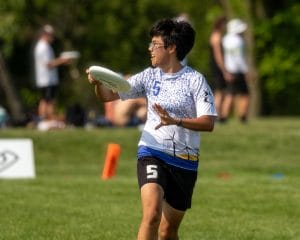
Rowan Dong (Carleton)
While they were left off the awards lists in 2023, Rowan Dong is a force to be reckoned with on Carleton College Eclipse’s D-Line. While Dong isn’t the tallest player in the division, their ability to dominate the aerial space, especially the deep space, forces opposing offenses to grind the disc up the field. This was even evident in several instances against Middlebury in the final. With Dong anchoring the D-Line again in 2024, expect them to continually find the end zone while they lead Eek break trains.
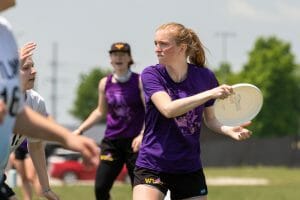
Skylar Yarter (Williams)
Skyler Yarter broke onto the scene at 2023 Nationals for Williams, throwing 25 assists alongside 11 blocks and 2 goals. Yarter is on another team with minimal losses to graduation, losing just five players. This only benefits Yarter, who’s entering their junior year at Williams and is poised to lead the team to a NE2 finish. Yarter will again anchor the O-line handler set but will likely cross over just as much as she did last season to gain blocks and generate breaks. Yarter received accolades last year as the BPOTY second runner-up and second team all-American, indicating her ceiling could be much higher for 2024, potentially even making the POTYium.
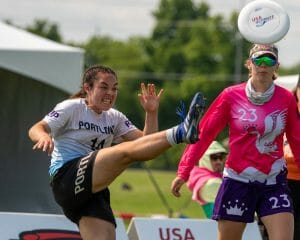
Julianna Galian (Portland)
You won’t be able to talk about Women’s D-III ultimate this season without talking about Julianna “JJ” Galian. The Portland UPRoar cornerstone is back to drop some dimes, snatch up goals, and mash some kick spikes. Last year at Nationals JJ slashed 15G/14A/7D with only 12 turns, good enough to lead her team in goals and co-lead in assists and blocks. The numbers don’t lie either; Julianna is the real deal, god’s honest baller. Moreover, her energy is infectious and her team seems to feed off of her hype and grit. Julianna could be the reason Portland wins their first ever Nationals this year.
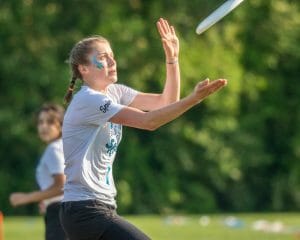
Gemma Munck (Whitman)
I’ll say it: leaving Gemma Munck off first team all-American last season was a snub. While Whitman underperformed at Nationals and team performance is always incorporated into the awards, Munck is an exceptional player. Munck dominated on the field, rattling off 22G/18A/11D, making her the highest production player at the tournament with 40 combined goals and assists. With another year of chemistry building on a team with minor losses compared to last season’s top finishers, Munck looks poised to continue to lead her team and be an unstoppable threat on the field.
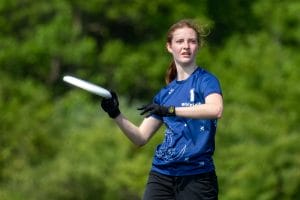
Bella Steedly (Wellesley)
After leading Wellesley in both goals and assists at Nationals, Bella Steedly is not done yet. Eyes are on Steedly to fill in the gap left by Tess Dolan, but this task is nowhere near daunting for this star player. Her arsenal of skills makes her every O-line’s dream player. It’s impossible to label her as a handler or cutter, but her throwing prowess makes her especially dangerous in the backfield. Steedley was present for both of Wellesley’s Nationals appearances and proved to be a formidable opponent each time. It would not be surprising to see her take the lead on the scoreboard again and spearhead Wellesley past a semifinal game.
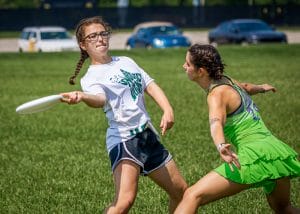
Zoe Costanza (Haverford/Bryn Mawr)
As a sophomore, Zoe Costanza had a prodigious run at Nationals, racking up 17 goals and 22 assists for Haverford and Bryn Mawr. Her aptitude for finding open space for herself and her teammates proved to be essential for the Sneetches’ pool play and quarterfinal appearance. Her high counts of goals and assists1 are attributed to her stamina and never-ending willingness to cut deep. She brings a great voice to each line and manages to remain composed even in painstakingly long points. Despite being primarily positioned downfield, Costanza is very comfortable in the backfield, working hard for give-gos and strike cuts. Her array of cutting and throwing skills will substantially contribute to the Sneetches’ chances of a longer run at Nationals.
Rising Stars
Big contributors to their teams who could make waves in the national spotlight for 2024.

Charlotte Moynihan (Mount Holyoke)
After an incredible rookie season, Charlotte Moynihan is certainly climbing to the top of Mount Holyoke’s roster. Her tenacity downfield made her the team’s top scorer last year and the third-highest blocker. She places immense pressure on defense and chases discs meant for either her or her opponents. High stall counts only encourage her to make throws that convert into goals. Despite being such a young player, Moynihan offers her team a greater chance of surpassing a quarterfinal game.
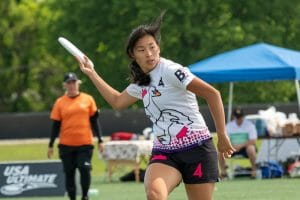
Lucy VanNewkirk (Middlebury)
Lucy VanNewkirk is just very good at ultimate. Great instinct for the game with good field awareness, the reigning ROTY has the ability to show up on either the DPOTY or OPOTY list this season. Look for VanNewkirk to lead the charge for the Pranksters’ cutting core and absolutely be the gum in the gears for opposing O-lines. It’s players like VanNewkirk who keep Middlebury at the top of the table year after year.
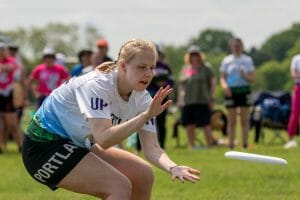
Hayden Ashley (Portland)
Tying for most assists on the team in her rookie season, Hayden Ashley is returning as one of Portland’s primary handlers. Her Nationals debut was filled with many yard-gaining hucks and wide-open resets. With a semifinal game under her belt, Ashley is expected to remain a valuable asset for Portland’s O-line and grow into a leader who will shepherd her team into a finals game.
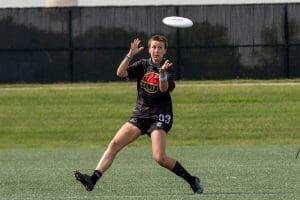
Frankie Saraniti (Carleton)
Always open and often in the end zone, Frankie Saraniti made a big impact at Nationals last year for the Eclipse. Saraniti hauled in 14 goals for Carleton, tying for first for her team with Rowan Dong. She accomplished this feat through her ability to effortlessly create space and win every jump ball situation she found herself in. Despite her small frame Frankie dominates the airspace with perfectly timed jumps to high point the disc. Frankie has some big cleats to fill with Carleton losing six impact seniors, but has already proven her ability to perform in high pressure situations.

Gabbie Campbell (Whitman)
Gabbie Campbell, like her teammate Munck, had an outstanding 2023, and that showed with 28 assists at Nationals. In this season, her favorite target is back along with several other dangerous targets, and Campbell is ready to grind up defenses with decisive handler cuts and chew up yards with big hucks. Whitman will be relying on Campbell to anchor the handler set, and she looks ready to rise to the challenge.

Unni Isaksen (St. Olaf)
Someone has to catch all of Leina Goto’s beautiful throws. More often than not, the receiver will be none other than Unni Isaksen. With 13G/6A/4D at 2023 Nationals, Isaksen is only going to continue to grow in 2024. At 5’10”, Isaksen will be a deep threat, but also has the confidence to make a crucial throw with the disc in her hands. St. Olaf benefits from major retention for this season, and the chemistry Isaksen has been building with Goto and her teammates could allow St. Olaf to rise in the division.

Emma Elliot (Michigan Tech)
A lesser known player who was last recognized on the awards list in 2021, Emma Elliot is poised to make a big impact in the division. A versatile player who is capable of dominating in the deep space or dusting defenders on under cuts, Elliot has expanded her repertoire recently to include popping or crashing through zones and throwing big continuations upfield. If Michigan Tech succeeds, Elliot will be a big reason why.
Deeper Cuts
Older players set to have a big breakout season in 2024 or younger players who could define the division for years to come.
Metro East
Maggie Brown (Wesleyan) – Seattle YCC, WJUC U20 for 2022
Scout Noble (Wesleyan) – Seattle youth handler, USA U20 for 2024
Ohio Valley
Anja Kottmann (Haverford/Bryn Mawr)
Phoebe Hulbert (Haverford/Bryn Mawr)
New England
Jamie Eldridge (Mount Holyoke)
Emily Stanger (Williams)
Joanie Cha (Williams)
North Central
Molly Horstman (Carleton) – 3 star YCC Player
Haniya Frayer (Michigan Tech)
Julia Mockert (St. Olaf) – 2 star YCC Player
Alexia Swiglo (St. Olaf) – 1 star YCC Players
Northwest
Ollie Fox (Whitman)
South Central
Casey Shaw-Merrigan (Colorado College)
Kelsey Viadro (Colorado College)
Sophie Roback (Colorado College)
You’re All Underrating…
Union Jillz
This team should be looking at a quarterfinal appearance this year, and have an outside chance at making the semifinal. I can understand the descension and doubt: they didn’t even earn the bid last year, they can’t get past Berry, they’re from the South East. All of these things are true. The difference this year is that the Jillz have the experience. They went to Nationals, played some of the best teams in the nation, and played well against them. More importantly the core members of that team from last year are returning, Tori Green chief among them. Another key factor for this team is the coaching staff, who were integral at propelling Union to their bracket run last year.
– Zack Davis
Colorado College Zenith
Colorado College made an appearance at 2023 Nationals after stealing the bid from their regional rivals in a tightly contested South Central ConfRegionals. These close games clearly prepared them for Nationals, where despite finishing 1-2 in pool play, they put together wins against Whitman and Mount Holyoke (with a loss to the Middlebury title-winning team in between). Looking ahead at 2024, Colorado College is in the same boat as other title contenders St. Olaf and Willliams with minimal losses to graduation, only losing four of 21 players on the Nationals roster. While they are down big contributors in Mary Andrews, Sophia Hennessy, and Grace Tumavicus, they return players ready to step up in Casey Shaw-Merrigan, Soumya Keefe, Sophie Roback, and Kelsey Viadro. If Colorado College can continue their 2023 success and rely heavily on team chemistry, they could make a push for semifinals this season.
– Anna Browne
Whitman Sweets
Whitman had a tough Nationals last season, falling to finish 10th after losses to Wellesley, Colorado College, and a universe point loss to Haverford/Bryn Mawr. While it’s tough to determine what Whitman team will be coming back, their twitter posts from this fall indicate huge returners including Gemma Munck, Gabbie Campbell, Ollie Fox, Ella Johnson and Josephine Bygrave. Munck and Campbell are the workhorses of this team, with Munck being that elusive cutter who can throw and Campbell unlocking the deep throws from back in the handler set. Whitman is a part of a rising region in the NW, and could easily make a deep bracket push come May, potentially breaking into semifinals or beyond.
– Anna Browne
Michigan Tech Superior Ma’s
It is no surprise we’re high on the North Central this year, with Carleton and St. Olaf set to fight for the regional crown and the national championship. But a third team in the NC is poised to throw their hat in the ring: the Michigan Tech Superior Ma’s. Tech is one of the few D-III schools with a graduate program, allowing players like Tessa Meyer and Laura Lyons to return in their 5th and 6th years, respectively. While the Ma’s lack 4th year players, they already were tested at Nationals on Saturday when the 2023 captains, Allyson Fenton and Audra Bialik, were away. Looking ahead to 2024, a large coalition of 3rd year players is poised to rise up with high level experience including two Nationals appearances. With more present coaching throughout the season, the Ma’s have the ability to shake up the regular season rankings and make a bracket push by highlighting key players like Emma Elliot, Haniya Frayer, Sidney Gillig, Serenity Snyder, and Lauren Saulino. If Tech can claim a third bid for the NC, they should be looking at a quarterfinals appearance.
– Anna Browne
Brandeis Banshee
A non-2023 Nationals team? Wrongly underrated? Yup, believe it. We’ve spilled more than enough ink already this primer about New England’s prowess, and Brandeis is yet another jostling for position amongst the division’s heaviest of hitters. It’s been a hot minute since Brandeis’ last dance at Nationals in 2021, when they went 0-2 in Regionals pool play only to flip the script on Williams in the bracket and proceed to beat no.1 seeded Amherst in the game-to-go. In 2023, Banshee flashed potential in the regular season, losing a tight 8-6 to eventual Nationals-quarterfinalists Mount Holyoke in quarters of New England Open. At the end of it all, they weren’t the closest to qualifying, falling to Bates in the game-to-go to the game-to-go after braving the Cold Front the day before. Bates then narrowly lost to Williams, and that was the region’s final bid.
So, the case for Nationals in 2024: Brandeis has already avenged that Regionals loss,2 cooking Bates 8-3 at Lobster Pot.3 They do graduate seven players, but so did seemingly most teams, and attending two tournaments in the fall season is an excellent way to grease the wheels and season the recruits.4. Is the case a little slim? Maybe. But if the New England Region is as open as we seem to think, why not Brandeis Banshee?
– Theresa Diffendal
Occidental WAC
Occidental has made it to Nationals every year since 2019 and has no intention of letting their streak burn out. Even when Occidental’s chances of making it to Nationals were looking dire, they managed to pull off a win against Claremont and brought their young team to Ohio. The story has changed for the Women’s Air Core – they no longer are the sole contender for the Southwest region’s bid. In addition, they haven’t made it past pool play at Nationals since 2021. However, they have done one thing that not a lot of teams are brave enough to do: they’ve invested in young players, such as their leader in assists, Lily van Linder. Placing their hope in growing talent will have high returns for WAC, and might just catapult them back into the championship bracket.
– Raquel Alegria
The Current Power Rankings
College D-III Women's Power Rankings:
| 1 | Middlebury |
| 2 | Carleton Eclipse |
| 3 | Portland |
| 4 | St. Olaf |
| 5 | Williams |
| 6 | Whitman |
| 7 | Colorado College |
| 8 | Wellesley |
| 9 | Haverford and Bryn Mawr |
| 10 | Mount Holyoke |
| 11 | Michigan Tech |
| 12 | Bates |
| 13 | Lewis and Clark |
| 14 | Union |
| 15 | Lehigh |
| 16 | Trinity |
| 17 | Occidental |
| 18 | Rice |
| 19 | Catholic University |
| 20 | Claremont |
| 21 | Wesleyan |
| 22 | Berry |
| 23 | Brandeis |
| 24 | Winona State |
| 25 | Cedarville |





